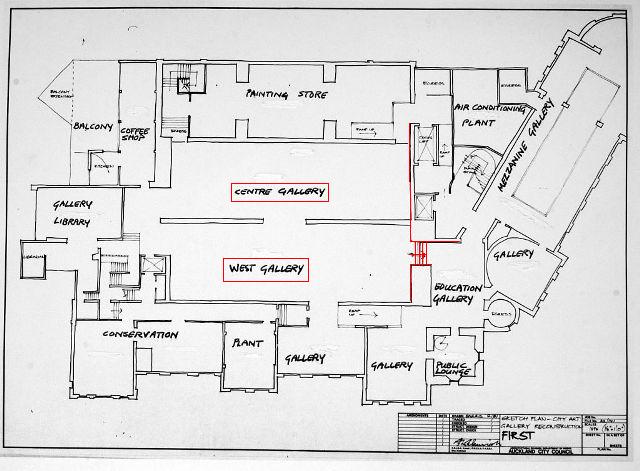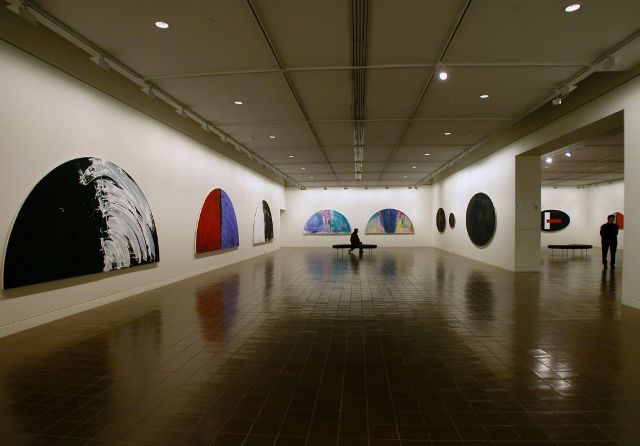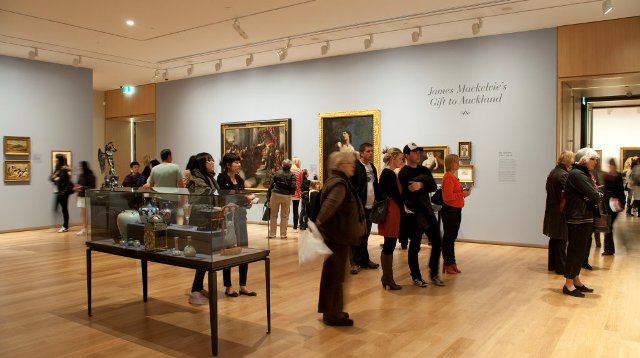Monday 28 November 2011
Anna Parlane
I recently wrote about a 1979 work by Billy Apple titled Revealed/Concealed. This was one of several artworks made by Apple at Auckland Art Gallery in the 1970s when he toured New Zealand’s art galleries, making site-specific works that turned a critical eye on the gallery spaces themselves.
Not long after he made Revealed/Concealed, Apple had the opportunity to effect a more lasting change in the fabric of the Gallery’s building.
In 1975, he had made an untitled piece which drew attention to a strange discrepancy in the sizes of what were then Auckland Art Gallery’s two main exhibition spaces on level 1. The Centre and West Galleries were almost identical, except that the West Gallery, for unknown reasons, was slightly longer. This offended Apple’s sense of spatial order and balance. He censured the extra area of floor by painting it the same white as the walls, visually ‘subtracting’ it so that when viewed from a distance it seemed to disappear – in Apple’s words – ‘so there’s no distraction.’
In 1982 this temporary re-proportioning of the West Gallery was made permanent. I recently talked to Richard Harris, who is now Principal architect at Jasmax, about how he helped Apple to realise Addendum to ‘Subtraction’.

Billy Apple, Addendum to 'Subtraction': The Given as an Art-Political Statement 1998
AP: Addendum to 'Subtraction' followed an earlier 1975 piece, where a section of the Gallery's floor was painted white. How did it come about that this work was revisited in 1982, and what was your involvement?
RH: The original Art Gallery was actually both the City Art Gallery and the City Library. In the early 1970s the Edmiston Wing was added to the Art Gallery end of the building and this addition/renovation included the Centre Gallery and the West Gallery. In the seventies the Auckland City Council opened a new City Library in Lorne St and this enabled the Art Gallery to annex the newly vacated library space.
At that time I was working for the Architectural Division of Auckland City Council and was appointed as the project architect for the City Art Gallery refurbishment and reconstruction which included a number of separate but related building projects occurring concurrently between 1979 and 1984.

Richard Harris, Sketch plan, Auckland Art Gallery first floor, 1981
[West Gallery new wall and stair shown in red]
One of these projects involved connecting the West Gallery into the old library and a small element of this was the need for a short stair to accommodate the height difference between the new and the old. To integrate the stair into the design, I chose to shorten the existing West Gallery and it was at this conceptual planning stage that I met Billy and he acquainted me with his Addendum to ‘Subtraction’work. I needed little encouragement to position the new wall exactly where he had painted the floor to create an apparent wall seven years earlier.
AP: Billy tells me that you were very particular about the new wall being 'right', to the extent that the bricklayer had to lay the wall three times over. Why was it so important to get it exact?
RH: The existing gallery walls were bagged brick with the individual bricks ‘kicked’ slightly and randomly to give a textured finish to the wall. The consistent texture over the whole wall was achieved through a degree of uniformity to this randomness. It was really important to us that the new wall exactly matched the texture of the existing ones so that they created a coherent space.
The problem for us was that West Gallery continued to show exhibitions during construction and the new wall was being constructed behind a screen which prevented the bricklayer being able to see the finish that he was charged with replicating. To get a good view of the existing wall, he had to leave the construction site at the corner of Wellesley St, walk up Kitchener St and walk back in through the main entry of the gallery. The other issue was that he was a very good bricklayer and ‘kicking’ bricks went against all his instincts. So it took three goes but the final effort was a great match.
AP: The space that became the Centre Gallery was originally built as an extension to the Art Gallery in 1893, and for some reason was made slightly smaller than the existing (West) Gallery. It was the first in a series of patchwork additions and renovations over the years which caused some odd angles and discrepancies in the building. Billy's project was an attempt to 'correct' at least one of these. Do you feel that architecture should display its history, discrepancies and all?
RH: Self imposed constraints of maximising gallery space while working within the existing walls of the building were probably what drove the different length galleries in the first place. Billy’s work allows us to look at space through clearer eyes provoking questions such as what were the intentions, why was it resolved that way and could it have been done differently. That a conceptual artwork was later able to be permanently realised added a richness to the project.
I do believe that architecture which displays its history allows for a deeper understanding of our built environment.

Gretchen Albrecht, Illuminations installation, Centre Gallery showing view into West Gallery, 2002
The Centre and West Galleries were changed again as part of the recent development project. Apple’s wall was moved slightly to make way for a new stairwell and the two spaces – now perfectly aligned – have been combined to form one large sequence of rooms on level 1.

Farmer Galleries [formerly Centre and West Galleries] 2011